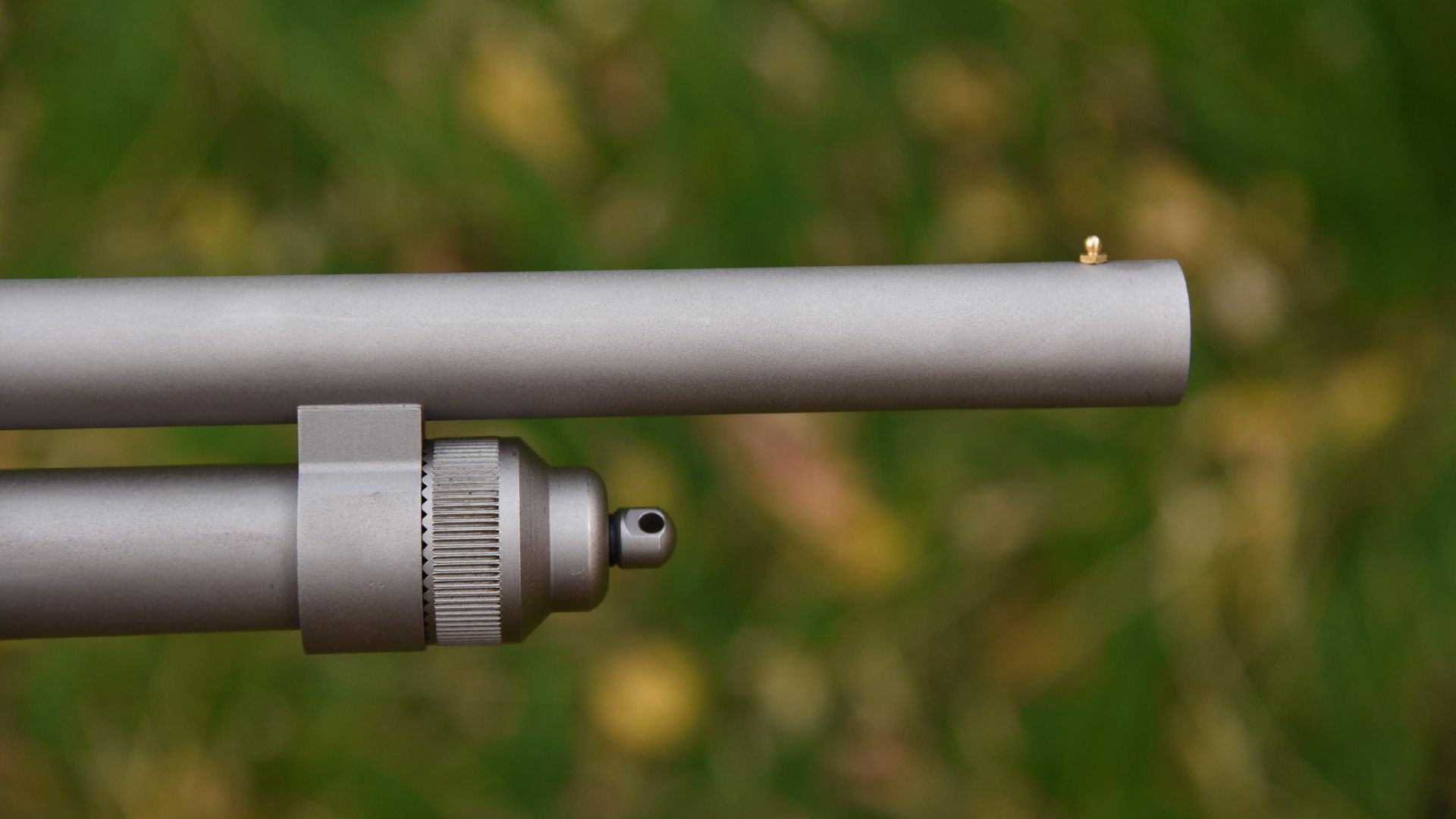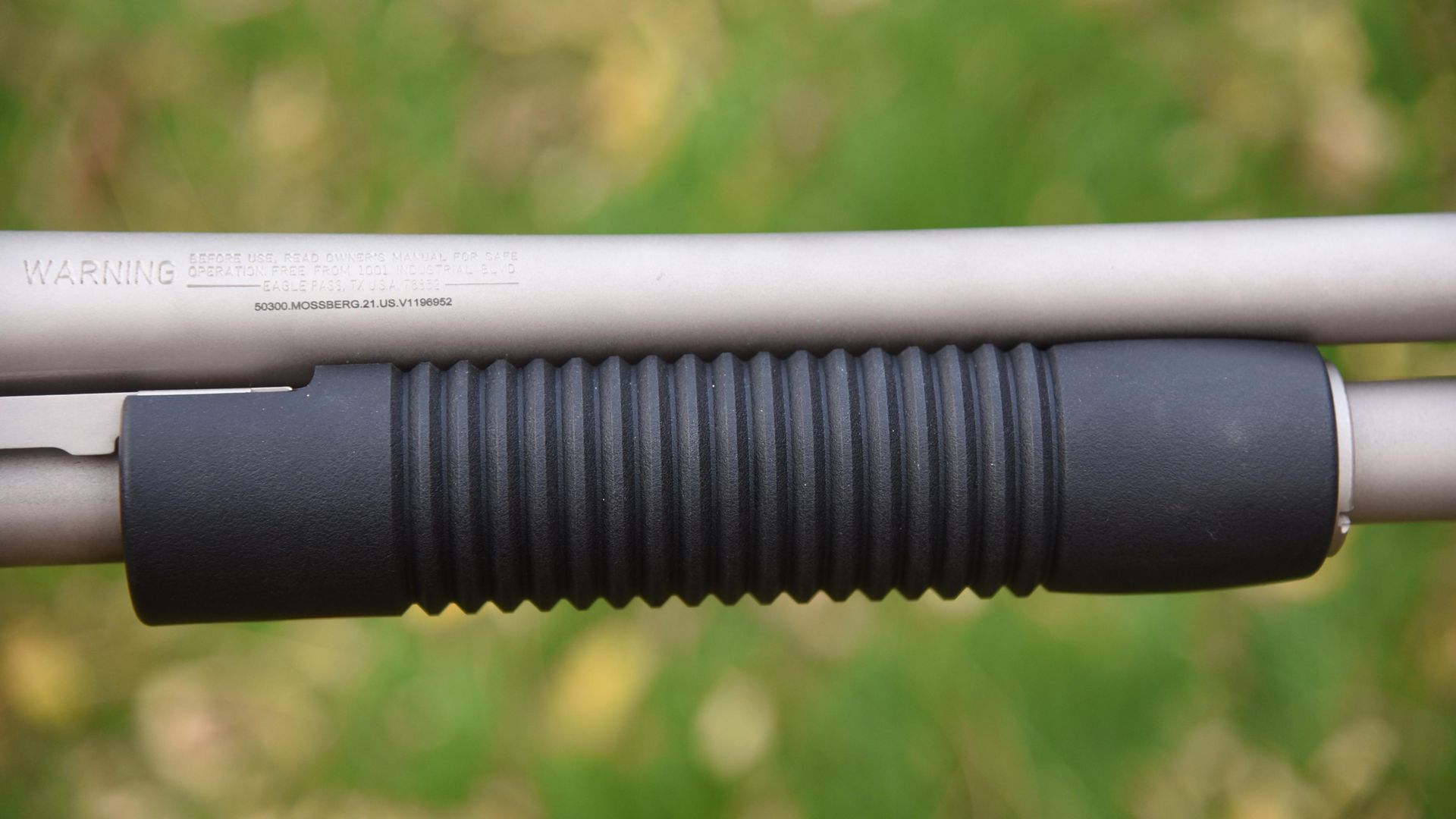Mike Yardley tests the Mossberg 590 Mariner shotgun, and assesses whether this state-side icon is suitable for British game
 credit: Mike Yardley
credit: Mike Yardley
We tested a belt-and-braces Mossberg last year and liked it, so I thought we’d better test another! This time it’s the slightly more upmarket Model 590 ‘Mariner’ – a short-barrelled, weatherproofed model with an anodised alloy action, well-proportioned synthetic stock, and special Cerakote barrel finish. It was supplied by Viking Arms of Harrogate and the cartridges used in this test were supplied by Lyalvale Express. Mossberg itself was founded in 1919 by Oscar Frederick Mossberg, a Swedish engineer who emigrated to the USA. The enormously successful 500 – and the test gun is within the 500 series – was designed, like the Remington 870, for industrial manufacture post-WWII. Mossberg, like other US gunmakers gained much experience with military mass production. The 500 was initially intended as a budget gun, but one of solid and dependable quality – “built rugged, proudly American,” as the good ol’ boys at Mossberg would say.
This iconic firearm has been made in many versions: a 12-bore, 20-bore and .410 since its launch circa 1960 (a 16-bore was briefly offered too but withdrawn in 1963). Our test gun is a 12-bore shorty with a plastic stock and ribless barrel of just over 24" (and hence within the UK limit for Section 2 allowing it to be held on a shotgun certificate). It has a 2+1 mag capacity (FAC 8+1 versions are available too) and the gun weighs in at 6.75lb – which is light for a repeater. The action is anodised alloy, the barrel Cerakoted as noted – carbon steel (not stainless as first glance might suggest). It is chambered for 2¾" and 3" cartridges, and bears Birmingham fleur-de-lys steel proof marks. The USA is not a member of the International Proof Commission (CIP), US-made guns must be proofed here before sale. Our 590 is cylinder-bored too, so it is potentially compatible with slugs as well as shot (most modern 500s are multi-choked using the shorter style Mossberg Acu-Choke).
 credit: Mike Yardley
credit: Mike Yardley
Mossberg 590 Mariner: first impressions
Initial impressions of the test gun are that it is plain but smart. Picking it up inspired confidence. It is surprisingly well balanced with the short barrel and handles nicely with plenty of weight between the hands. The point of balance is about an inch forward of the receiver. Looking down the rib is a little unnerving because there is no aiming aid, bar the well-sized brass bead (all the more reason just to lock focus onto the target). The fit is a little short (the length of pull is 14¼") and the comb a little low (drop measurements are 15/8" forward and 2½" at heel. You can lose the bead quite easily if you put your head down, but surprisingly, this did not turn out to be a major problem when shooting).
One feature of all 500 series guns which may endear them to British users is a top-mounted sliding safety – much like those on double guns. It’s a little stiff on the test gun, but positive. You won’t have to retrain yourself much if you are not familiar with repeaters. I would make two other safety points here regarding repeaters: always check the mag tube carefully as well as the chamber when clearing one. And, when carrying any repeater (pump or semi-auto) on a clay layout, always do so with action open and a flag or handkerchief in the ejection port. In any situation, I prefer to carry one keeping the muzzles near vertical too.
The Mossberg 500, meantime, is one of the most successful shotguns of all time with 11 million sold. Well priced, it has appeared in all sorts of versions including a muzzle-loader and a line-throwing gun. Recently, a double-stack magazine-fed version of the 590 has been introduced. The 500 series has also spawned an industry of retro-fit add-ons. It is available in extended five- and eight-shot magazine variants and has proved popular with both the police and military. It has also been used in the UK as the basis for sound-moderated Hushpower guns in various bore sizes. I have used both the 20-bore and .410 Hushpower Mossbergs and found them to be very efficient and reliable pest control tools.
What about pump guns generally? Traditionally, they tended to be frowned upon here – though they had their following amongst wildfowlers and pigeon shooters – both because of their repeating capability and because you couldn’t easily see if they were unloaded). Our heritage was small scale bench manufacture (with exceptions) not the industrial processes that became most popular in the US thanks to war and Henry Ford. The repeater was perfected in the US (notably by John Browning), but the double gun in Britain. The semi-automatic, meantime, simply used a pump action where recoil energy or gas is used to cycle the mechanism.
 credit: Mike Yardley
credit: Mike Yardley
Mossberg 590 Mariner: technical overview
The Mossberg 500 shotgun was designed by Carl Benson, the firm’s chief designer in the 1950s. The enormously successful Winchester Model 12 pump – the hammerless design that set the standard for repeating guns at the beginning of the last century – had a single action bar (the bar that connects the bolt assembly to the sliding fore-end).
The 500 copied this on its introduction. Remington, however, introduced double action bars in their guns. Mossberg adopted them circa 1970 when Remington’s patent protection lapsed. The 500 design is sensible, simple and strong – intended for assembly with minimal hand fitting. There is a weight-saving forged aluminium receiver housing a steel bolt which locks into an extension of the barrel.
This gun, in essence, is a mil-spec 500, adopting the usual repeater configuration with a magazine tube beneath the barrel which is also used as a guide ‘rail’ for the moving fore-end.
The gun looks as if it might be stainless but, as explained, it’s a combination of anodised aluminium and Cerakoted steel. Winchester did once offer a similar 1300 Marine in stainless.
 credit: Mike Yardley
credit: Mike Yardley
Mossberg 590 Mariner: shooting impressions
I had lots of fun with the 590! It shot much better than I was expecting – short barrel and absence of rib and choke not withstanding. We put it through it’s paces, as usual, on a skeet layout first. It did the biz in fine style with no glitches and nothing escaping.
What surprised me though was when attention was turned to some long crossers, the 590 continued to break birds in fine style. I thought the short barrel and lack of rib and choke might cause an issue, but there was no problem provided you locked hard focus on every bird. The cycling was easy too; I had no malfunctions and the recoil was less than expected with our usual Lyalvale 28g test loads.
The last time I tested a 500 it was hard to fault, and this 590 created no exception. The gun looks basic, but it works well. It would be an ideal tool for a keeper or farmer or anyone working in wet areas. It’d be a good expedition gun too.
I’d certainly take the 590 wildfowling (and forget about the choke and barrel length), it would be handy in a hide too.
Tech specs
Make: Mossberg
Model: 590 Mariner
Type: Twin action-bar pump with single locking lug.
Bore: 12 (with 20 and .410 options)
Barrel: 24” (no options in this model)
Proof: 3” steel with Birmingham marks
Weight: 6.75lbs.
SRP: £840
We liked
- The solid, simple design
- The fast handling and relatively light weight
- Easy take-down and assembly
We disliked
- The anodised finish seemed prone to marking
- The stock is a little short (but might suit with thick clothing)
- The comb is a bit low